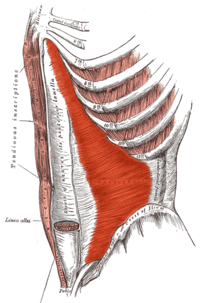Transversus abdominis muscle
| Transversus abdominis muscle |
|---|

|
| Transversus abdominis muscle |
| origin |
| Outer two thirds of the ligament. Inguinal , iliac crest , anterior superior iliac spine, thoracolumbar fascia , cartilage, the lower six ribs |
| approach |
| Linea alba , crista pubica |
| function |
| Compression of the abdomen, lowering of the ribs, expiration
ipsilateral rotation (with unilateral rotation) |
| Innervation |
| N. intercostal , subcostal nerve , ilioinguinal nerve , N. iliohypogastricus |
The transversus abdominis muscle ( Latin for "transverse abdominal muscle") is a skeletal muscle and belongs to the group of abdominal muscles . The name refers to the direction of the fibers of the muscle, the muscle is the deepest of the flat muscles of the abdomen and is located below the obliquus internus abdominis muscle .
The transversus abdominis muscle has both a planar origin and insertion tendon ( aponeurosis ). The origin extends from the lower six costal cartilages over the lumbar spine via the thoracolumbar fascia , iliac crest and inguinal ligament . The attachment tendon extends from the sword extension of the sternum to the pubic bone and forms the linea alba with the tendons of the oblique abdominal muscles . This insertion tendon forms an arched line to the edge of the muscle ( linea semilunaris , 'crescent-shaped line'), which participates in the inner leaf of the rectus sheath .
function
The transversus abdominis muscle is responsible for compressing the abdomen ( abdominal press ) and lowering the ribs. He is also involved in expiration (exhalation). The extent to which the muscle is involved in the rotation of the trunk to the same side (ipsilateral) during unilateral contraction is controversial. In addition, it helps to stabilize and straighten the trunk and, via the sideways pull on the thoracolumbar fascia, to stabilize the lumbar spine.
Individual evidence
- ↑ a b Walther Graumann: Compact Textbook Anatomy . tape 2 . Schattauer, Stuttgart 2004, ISBN 978-3-7945-2062-6 , pp. 67-68 .
- ^ Alison Middleditch and Jean Oliver: Functional Anatomy of the Spine . 2nd Edition. Elsevier Health Sciences, 2005, ISBN 978-0-7506-2717-7 , pp. 125 .